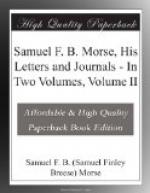On September 6, after visiting the catacombs, he goes to the Convent of St. Martino, and indulges in this rhapsody:—
“From a terrace and balcony two views of the beautiful scenery of the city and bay are obtained. From the latter place especially you look down upon the city which is spread like a model far beneath you. There is a great deal of the sublime in thus looking down upon a populous city; one feels for the time separated from the concerns of the world.
“We forget, while we consider the insignificance of that individual man, moving in yonder street and who is scarcely visible to us, that we ourselves are equally insignificant. It is in such a situation that the superiority of the mind over the body is felt. Paradoxical as it may at first seem, its greatness is evinced in the feeling of its own littleness.... After gazing here for a while we were shown into the chapel through the choir.... In the sacristy is a picture of a dead Christ with the three Marys and Joseph, by Spagnoletto, not only the finest picture by that master, but I am quite inclined to say that it is the finest picture I have yet seen. There is in it a more perfect union of the great qualities of art,—fine conception, just design, admirable disposition of chiaroscuro, exquisite color,—whether truth is considered or choice of tone in congruity with the subject’s most masterly execution and just character and expression. If any objection were to be made it would, perhaps, be in the particular of character, which, in elevation, in ideality, falls far short of Raphael. In other points it has not its superior.”
Returning to Rome on September 14, the only entries I find in the journal for the first few days are, “Painting all day at home,” and a short account of a soiree at the Persianis’.
“Monday, September 20. Began the portrait of the celebrated sculptor Thorwaldsen. He is a most amiable man and is universally respected. He was never married. In early life he had two children by a mistress; one, a daughter, is now in a convent. It was said that a noble lady of England, of great fortune, became attached to him, and he no less to her, but that the circumstance of his having two illegitimate children prevented a marriage. He is the greatest sculptor of the age. I have studied his works; they are distinguished for simple dignity, just expression, and truth in character and design. The composition is also characterized by simplicity. These qualities combined endow them with that beauty which we so much admire in the works of Greece, whether in literature or art. Thorwaldsen cannot be said to imitate the antique; he rather seems to be one born in the best age of Grecian art; imbued with the spirit of that age, and producing from his own resources kindred works.”
The following letter was written by Morse before he left Rome for Naples, but can be more appropriately introduced at this point:—




